Balancing the past and progress in Shulinab
The Macushi village keeping its heritage alive while forging a sustainable future


Sunday, March 30, 2025

The Macushi village keeping its heritage alive while forging a sustainable future


Sunday, March 30, 2025
By Michel Outridge
IT was out of the need to be fully employed to earn more to offset expenses in the home as a young man just starting out that caused veteran jeweller, Andrew Rampersaud, to train himself in the skill of jewellerymaking.
Narrating his story, Singh said after he formally exited high school, he w orked at the then J.P. Santos Store for one month, and when he collected his pay at the end of that month, he was dismayed.
The monthly salary could not sufficiently offset his personal expenses of food and travel, among other things, and he de-
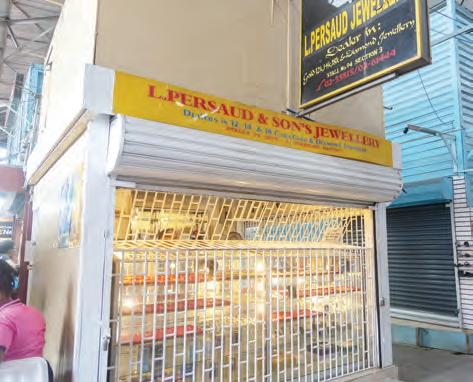
cided to quit.
“When I got my salary that month, it was like nothing because it all went back into transportation, food, and personal expenses, and I was really
worried about my life,” he said.
He added that at that time, he used to live in Alexander Village, and his upstairs neighbour was a goldsmith, so he

asked him if he could be trained, and he agreed to give him a job.
Rampersaud stated that he worked with him for two months, after which he went on to work with other goldsmiths for three years until he managed to start his own goldsmith workshop.
The jeweller related that he started his goldsmith small business at Vreed-en-Hoop, West Coast Demerara until he established himself. He now operates his jewellery business from a stall in Stabroek Market, Georgetown.
Rampersaud told Pepperpot Magazine that, to date, he has spent 34 years as a goldsmith and has employed one permanent employee while his spouse assists him in the stall with sales.
The father of four—all daughters—stated that years ago he had another stall in Stabroek Market, but business was slow and he migrated to Trinidad and Tobago for seven years.
However, he returned to Guyana in 2022, and he re-opened his jewellery business in Stabroek Market via a stall at the second entrance from the Georgetown to Vreed-
en-Hoop Stelling—the first jewellery stall named L. Persaud.
It was in July 2022 that Rampersaud set up his jewellery store in the market and began his
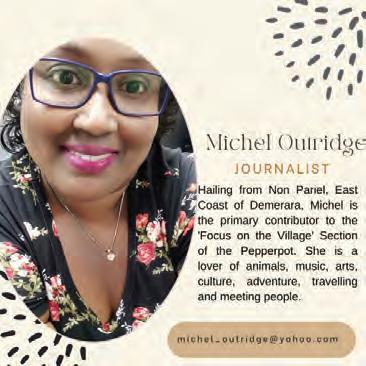
in the business of jewel-making, he has his own ideas and concepts, and he would visualise his


small business, where his unique pieces in both gold and sterling silver jewels are displayed for sale—also the same location where made-to-order jewels can be arranged.
The goldsmith reported that after 34 years
own designs and create them from scratch to remain competitive and in line with new trends and styles in jewellery-making.
Rampersaud said precious stones, diamonds, and pearls are sourced
TURN TO PAGE VII

By Shaniya Harding
IN the quiet village of Shulinab, South Rupununi, Rosanna Lewis starts her day before the sun fully rises. By 05:30 hours, she is already making her way to the community kitchen, ready to prepare the first meal of the day for the children of the village. For 13 years, she has been one of the dedicated cooks in the local feeding programme, ensuring that the youngest members of Shulinab receive nutritious meals every school day.
Shulinab is a traditional Macushi village surrounded by rolling savannahs and backed by the famed, majestic Kanuku Mountains. The community, like many others in the Rupununi, thrives on a mixture of subsistence farming, small-scale livestock rearing, and government-supported initiatives. It is a place where daily life is shaped by community values—where families rise with the sun, children walk to school in groups, and villagers come together to support one another.
Among the 425 villagers of Shulinab is Rosan -
na, whose commitment to the feeding programme has become a quiet but essential part of village life. The programme provides meals for approximately 100 chil-
afternoon. “Sometimes in the morning, we just get rushed for breakfast. The children ask for more, so we got to prepare more than we used to before,” Rosanna stated.

increasing population. In a village where many families rely on farming and occasional work, the feeding programme ensures that children have at least two solid meals each day.
Rosanna and the other cooks plan their menus in advance, making sure that every meal is balanced, nourishing, and a bit different from day to day. Breakfast is usually a simple but filling meal—perhaps farine with milk or porridge— while lunch features staples like rice, greens, and meat or fish. The goal, Rosanna says, is to provide the children with the energy they need to focus in class and stay active throughout the day.

dren across the nursery and primary school levels, serving breakfast in the early morning and lunch in the
The demand for meals continues to grow, a reflection of both the programme’s importance and Shulinab’s
Rosanna’s dedication to the programme is also personal. As a mother of seven, she understands the challenges of raising children in a remote village. Although most of her children are now grown, she remembers a time when providing for them was not always easy. “Raising kids in Shulinab was difficult. At that time, they never gave us cash grant. Now, they are giving, and I don’t have no more children,” she stated.

Despite the struggles of the past, Rosanna ensured that her children received an education. Today, two of her sons are teachers, one is a health worker, another is involved in construction in Georgetown, and another lives in Lethem. Her youngest is still in school, and the income from her job in the feeding programme helps support her.
Rosanna’s journey as a cook began with a training programme years ago. “I just put myself to learn. First, we were on a training, and then I decided to put myself to help the children—to feed them good food, proper food,” she stated. When the school feeding initiative was introduced in the village, Rosanna and several of her friends stepped forward to take on the role. It was a natural decision—one that aligned with her values of service and community support.
Her daily routine is demanding. She wakes up before dawn, often skipping her own breakfast, to ensure that the children’s meals are ready on time. By 07:30 hours breakfast is served.
After a brief break, she and the other cooks begin preparing lunch. Every day, they work with efficiency, knowing that their efforts directly impact the well-being of the village’s children. Shulinab, like many Indig-
enous communities in the Rupununi, is changing. Government projects have introduced new infrastructure, and opportunities for young people are growing. Rosanna acknowledges these developments but believes that the sense of community remains strong. “There are buildings coming up—the government giving them their projects and so forth. That’s what they’re trying to do with it,” Rosanna stated. While change is inevitable, the heart of Shulinab still beats, in the same way, it always has—with communal support and traditions at its core. The school feeding programme is just one example of this, ensuring that no child goes hungry and that education remains accessible to all. For Rosanna, the work is more than just a job—it’s a way of giving back to the community that raised her.
Rosanna hopes that the feeding programme will continue to expand, reaching even more children in need. At 51, Rosanna has no plans to slow down. Her hands, which have prepared thousands of meals over the years, continue to work with care and purpose. Whether she’s stirring a pot of porridge at dawn or serving a plate of steaming rice at noon, she intends to continue serving her community.
By Shaniya Harding
AMONG the
red-dusted Indigenous communities of the Rupununi, the village of Shulinab stands out as one of the only Macushi-speaking communities in the South Rupununi. Located just outside of Lethem, Shulinab has
worked to preserve its vibrant cultural heritage while continuing to pi oneer new initiatives and projects for the community.
Under the guidance of Toshao Nicholas Fredericks and a dynamic group of local councillors, Shulinab is upholding its time-honour ed traditions—from rodeo
events to agr o-processing—while simultaneously embracing ne w development projects in infrastructure, aquaculture, and tourism.
In an interview with Pepperpot Magazine, Toshao Fredericks shared insights into the deep-rooted customs that define Shulinab’s identity, as well as the

transformative efforts being made to blend tradition with sustainable development seamlessly
Honouring Tradition and History
traditions is the annual rodeo event, which has become synonymous with communities like Shulinab. For Shulinab, rodeo is not just an event; it illustrates the community’s
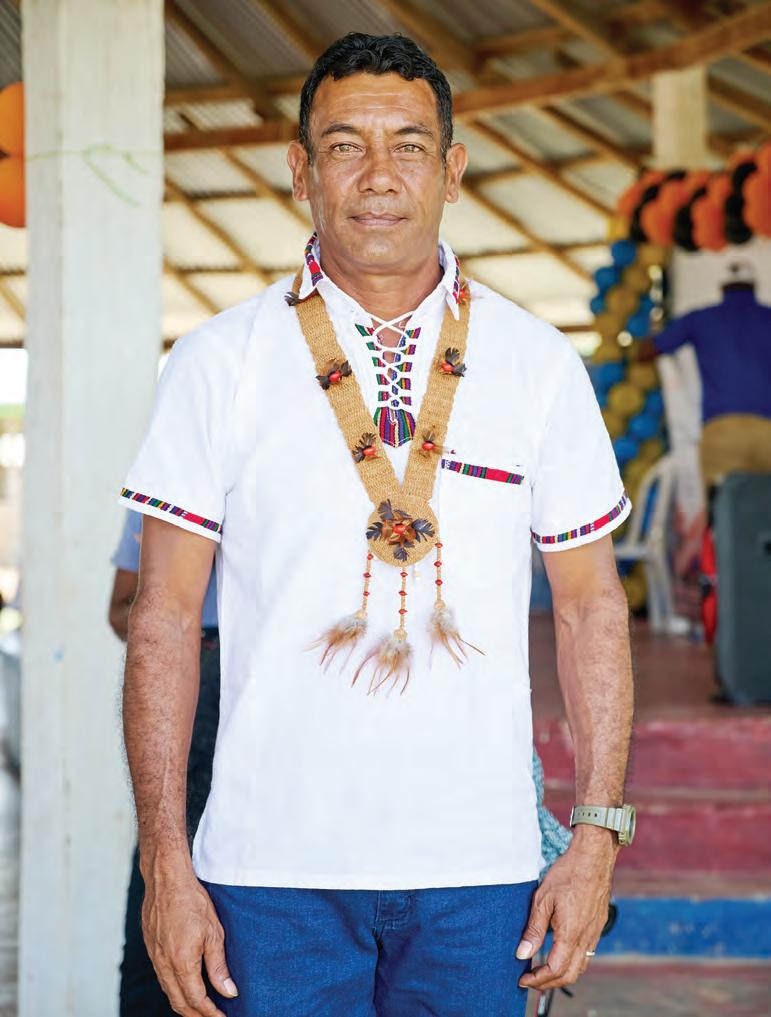
For generations, Shulinab has maintained its distinct cultural practices, language, and way of life, making it one of the last strongholds of the Macushi language in Guyana. The village’s connection to its past is evident not only in the language spoken by its people but also in the cultural practices they uphold.
One of the most prominent of these
deep-rooted connection to livestock production and cowboy heritage. The village’s long-standing tradition of cattle farming, herding, and horsemanship is what makes the rodeo a unique celebration.
As the region gears up for rodeo season, Shulinab is preparing its famed bucking broncos for competition. “Rodeo is an important tradition for
us because livestock and cowboy skills are essential here,” Toshao Fredericks said. He added, “Our women prepare and sell traditional foods at the event, such as farine, sour bread, and local beverages. This year, we will have a booth at the Lethem Rodeo, and we invite visitors to come and experience our culture firsthand.” The rodeo is not only a cultural celebration but also an important economic opportunity for Shulinab. The event attracts hundreds, if not thousands, of tourists each year, allowing the community
By Michel Outridge
ANDREW Albert, former Toshao of Karasabai, South Pakaraimas, was a farmer 25 years ago. Today, he has a more important role to play in the community—as a counsellor who travels to the eight villages in the sub-district to listen to locals, address their concerns, and provide assistance.
The eight villages include Karasabai, Rukumuta, Yurong Paru, Tiger Pond, Tipuru, Karabaicru,
Kokshebai, Pai Pang, and Taushida.
The 52-year-old told Pepperpot Magazine that he is attached to the Social Welfare Department of the Ministry of Amerindian Affairs and is a trained counsellor among the locals.
Albert, the father of three daughters and a native of Karasabai Village, Region Nine (Upper Takutu-Upper Essequibo), said life in that part of the country is fair, noting the rapid development in recent times to bring about an enhanced life for the locals.



As a remote village, he stated that things aren’t as busy as in the city or some other parts of Guyana, but they have had their share of development in the community.
Albert added that he is assigned an All-Terrain Ve-
hicle (ATV) from the Ministry of Amerindian Affairs and utilises it to visit the neighbouring villages—also far-fetched—to listen to and address the concerns of the people.
Even at a young age, it was recognised that he
had the inbred gift of being a counsellor. Due to his listening ear and advanced understanding of life, he is able to relate to people on all levels.
The Karasabai resident told Pepperpot Magazine that even before he was the Toshao, he had the skills to effectively communicate with people and put them at ease no matter what the issue was.
Albert was also a regional councillor, known and well-liked among the people. He is also an avid participant in wildlife conservation and spends his spare time studying cagefree animals such as the sun-kissed parakeet, jaguars, and anteaters.
The counsellor reported that he is also involved in the camera-trapping of birds—to study them and
then release them back into the wild. That project is at the community level with trained locals.
Albert is involved with the Guyana Tourism Authority (GTA) and is a licensed tour guide who is very familiar with the village and the sub-district communities.
He revealed that Karasabai is the only place where the sun-kissed parakeet can be found. He is a fan of the birds and has partnered with several agencies, including Caiman House, Rewa Lodge, and Conservation International, on wildlife projects.
Apart from domestic violence and teenage pregnancies, Albert disclosed that three households in every village often need external assistance for ba-
TURN TO PAGE XVI
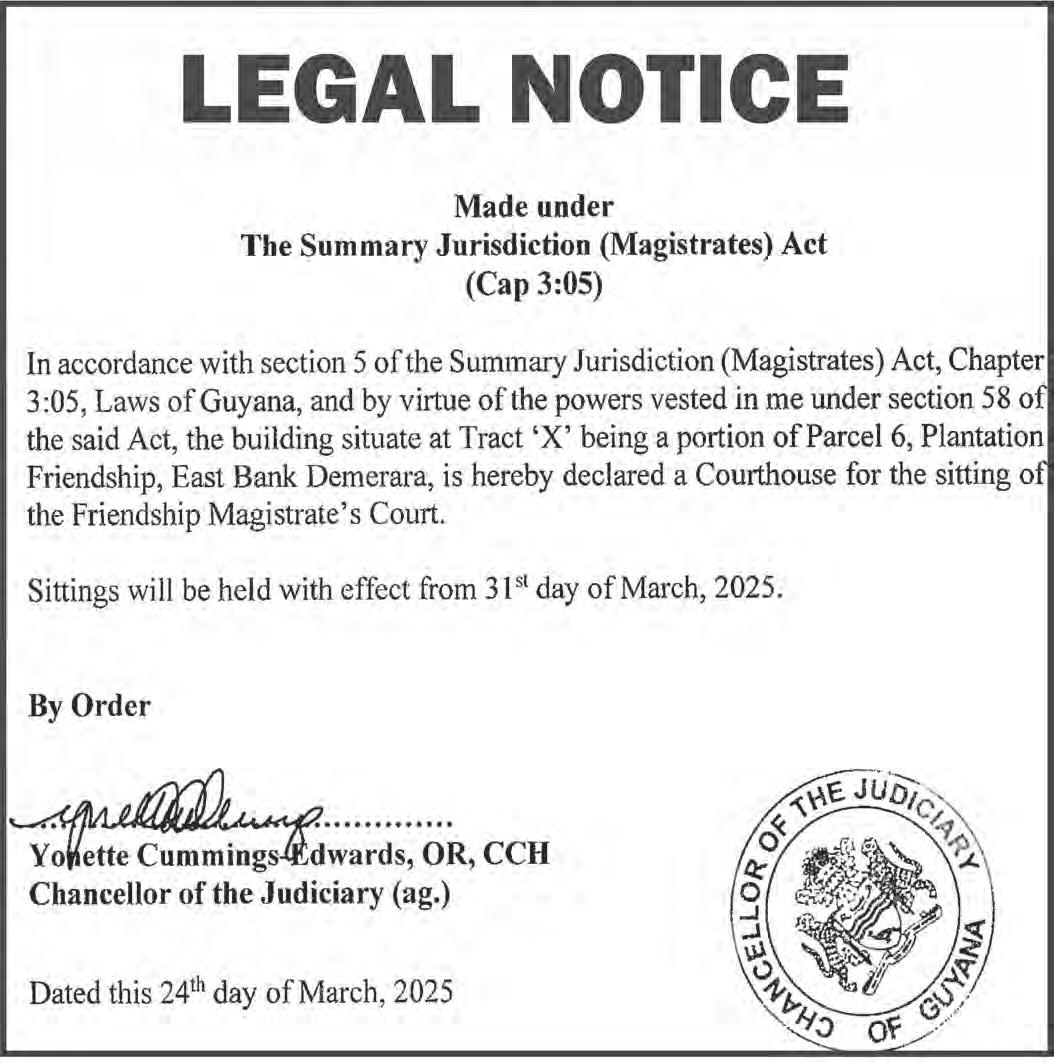
IN the world of event planning, the challenge is always to create something fresh, captivating, and unforgettable. For entrepreneur a nd founder of Kids Fest, Natalya Thomas-Small, this challenge has given rise to something truly magical—a grand experience that
blends fantasy, amusement, and wonder. With her upcoming event, Magical Moments, slated for April 20th and 21st, Natalya aims to bring an immersive fairytale adventure to life, promising attendees a spectacle unlike anything they’ve seen before.


In an interview with Pepperpot Magazine, Natalya describes her event as more than just a gathering—it's an experience, a journey into enchantment. “A magical moment is basically coming to experience a whole new adventure,” she explained. Central to this vision of an immersive event is an enormous castle, standing an impressive 70 metres in height. Starting in 2017 with event planner and designer Natalya Thomas-Small, K ids Fest 592 aims to provide children and their families with engaging experiences that foster creativity, confidence, and cultural appreciation.
But while the event carries hints of a Disney-inspired aesthetic, Natalya has been deliberate in ensuring that it remains unique. “Searching for a theme is a task because you have to ensure that it's different. It hasn't been done before. As much as it's a Disney theme, it's also not specifically
directed to Disney. It’s a more open concept because Disney is one aspect of magic, but there are other aspects that can come together and merge,” she stated.
This fusion of magical elements is at the heart of Natalya’s creative approach and has been a pioneering principle for all of her past events. “As much as I wanted to say it’s a Disney theme, it's not holistically a Disney theme. It's a multitude of things coming together to give you that rush,” she explained. From classic fairytale aesthetics to larger-than-life inflatables—including a giant dinosaur—Thomas envisions a dreamlike environment where different magical worlds collide.
One of the most exciting aspects of the event is its appeal to young girls, particularly through the princess pageant, which has seen a surge in interest. “This year, we have a lot of young ladies signing up—a lot of
TURN TO PAGE II
from a local dealer—a certified gemologist—for made-to-order jewels.
But he has in stock a wide variety of gold and sterling silver rings, earrings, bangles, bands, bracelets, chains, and other pieces.
At his jewel stall in
display for sale. The owner of A and N Jewellery Store in Stabroek Market, Georgetown, says it is a dangerous venture with risks, but he loves his job of creating exclusive pieces for his customers.
He explained that the experience is like learn-


Stabroek Market, the goldsmith has on display a variety of jewels to choose from in well-illuminated showcases and at a corner spot, which is easily accessible.
Rampersaud has a collection of birthstone rings, machine-made chains for everyday wear, and initials earrings, among other ready-made jewels on
his customers to suit their budgets. He is also very generous at any given time and has a pleasant personality that matches his good qualities.
As a small business owner, he gives back to society on a daily basis, even though some days he doesn’t sell a single piece of jewellery at his stall.
Despite challenges, Rampersaud is trying his utmost to keep up with jewellery trends to remain competitive since there are many jewellery stalls in the market and to keep his business functional as he has to pay a full-time staff member.

ing something new every d ay—he would picture a design in his head and eventually draw it and create the piece from scratch in his workshop, then put it on sale to see how it goes, after which the next step is repeated. What is unique about Rampersaud’s jewellery business is that he is very honest and works with

FROM PAEG IV
to showcase its cowboy skills, traditional foods, and crafts.
Preparations for the rodeo have already begun, and excitement in Shulinab and throughout Lethem is evident, with residents gearing up in their own ways.
This year, Shulinab is playing a key role in kicking off Rodeo
2025. “On the 4th and 5th of April, we will be hosting a rodeo in Fairview, one of our satellite communities, to start the rodeo season. We are grateful for the


For generations, Shulinab has maintained its distinct cultural practices, language, and way of life, making it one of the last strongholds of the Macushi language in Guyana (Samuel Maughn photo)
sponsorship and support from the Ministry of Nat ural Resources, businesses in Lethem, and other agencies. Our community provides bucking broncos for the regional rodeos, and we will be doing so again this year. We are also sending participants to compete and showcase their skills,” Toshao Fredericks explained.
Embracing Development and Change
While tradition remains at the heart of Shulinab, the village is equally committed to embracing progress and change. Through strategic developmental projects, the community is actively working to improve infrastructure, create new economic opportunities, and safeguard its environment and rich natural flora and fauna. These projects, many of which are supported by the government and local entrepreneurs, are transforming the village, bringing new opportunities and industries to the community.
“The name ‘Shulinab’ comes from a palm t ree that once existed only in this part of the village, on the northeastern side near the Kanuku Mountains,” Toshao Fredericks shared.
With a population of approximately 425 people and two satellite communities, Shulinab’s progress has
been nothing short of impressive. In recent years, the village has benefitted from several government interventions aimed at improving infrastructure and economic opportunities. These include a floodlights programme, a multi-purpose centre currently under construction, and a brick factory project that will provide employment and reduce the village’s dependence on outside sources for construction materials.
Additionally, the village is expanding its li vestock programme.
Speaking about some of the other ongoing projects, Toshao Fredericks stated, “We are also implementing an aquaculture programme to reduce pressure on natural ecosystems while providing an alternative food source and livelihood for residents.”
The agro-processing programme has become a source of pride for the women of Shulinab. Their ability to turn surplus fruits into valuable products has bolstered the local economy and reduced food waste.
Moreover, their work in agro-processing helps to preserve cultural knowledge of traditional food preparation. “Our women’s group is very active in agro-processing. We process local fruits like mangoes and cashews that would otherwise
go to waste, turning them into dried fruits, pulps, and preserves for children and visitors. These initiatives not only help us to reduce waste but also create new income streams for our families,” Toshao Fredericks stated.
Shulinab’s commitment to sustainability is evident not only in its ef forts to protect the environment t hrough aquaculture and agro-processing but also in its growing interest in tourism. The village is well-positioned to offer visitors a unique cultural experience, where they can learn about Macushi traditions, explore the natural beauty of the surrounding savannahs and mountains, and participate in the annual rodeo festivities.
“We also see tourism as a key part of our development. Shulinab is an easily accessible area for tourism, and we are working to develop this sector further. We want people to visit and learn about our community, our culture, and the sustainable projects we are working on,” Toshao Fredericks shared.
As Shulinab moves forward, its leaders and residents remain focused on the delicate balance between honouring their past and building a sustainable future.





ON March 30, every year, we observe International Day for Zero Waste—a day to promote sustainable waste management and encourage the reduction of waste generation. This observance aligns with the goals of the Environmental Protection Agency (EPA), which works to minimise waste, conserve resources, and reduce pollution across the country.
Waste management is an ongoing challenge in Guyana, particularly in urban areas like Georgetown, where improper disposal practices lead to environmental degradation. The EPA is actively addressing these challenges by promoting waste reduction, recycling, and responsible disposal practices.
The EPA is working alongside communities, busi-
terials, such as biodegradable options.
Adopting the Zero Waste Approach
The Zero Waste approach focuses on reducing waste at its source, reusing materials, and recycling what’s possible. The core principles of Zero Waste include:
• Refuse what you don’t need
• Reduce what you do need
• Reuse what you can
• Recycle what’s left
• Rot (compost) organic waste
By incorporating these principles into everyday life, we can help reduce the environmental burden of waste. While progress is being made, achieving Zero Waste will require continued effort from all sectors—government, businesses, and individuals.
Moving Forward: A Collaborative Effort

nesses, and organisations to improve waste management practices nationwide. While there are existing policies in place, such as those aimed at reducing plastic waste, the EPA recognises the need for more comprehensive solutions, particularly in areas like waste segregation and the disposal of hazardous materials.
One of the EPA’s key focuses has been raising awareness about plastic pollution, a major environmental issue in Guyana. Through education campaigns and community engagement, the agency encourages the public to reduce plastic use and consider alternative ma-
As Guyana develops, effective waste management will be key to safeguarding our environment and public health. The EPA is committed to guiding this process, but success will depend on the active participation of communities, policymakers, and private sector partners.
On International Day for Zero Waste, we encourage everyone to take responsibility for their waste and adopt sustainable practices that will benefit our country and future generations.
Happy International Day for Zero Waste, and let’s work together for a cleaner, greener Guyana.
You can share your
ideas and questions by sending letters to: “Our Earth, Our Environment”, C/O Communications Department, Environmental Protection Agency, Ganges Street, Sophia, GEORGETOWN, or email us at: communications@epaguyana.org. Follow us on Facebook and Instagram and subscribe to our YouTube channel.











IN the social and economic revolutions that have quietly progressed in G uyana, the programme of renewing and modernising the educational system has been most notable. New subjects s uch as Computers and Artificial Intelligence are being introduced in schools, and the old subjects are being brought up to date at the primary and secondary levels. A serious effort is being made to extend tertiary and university education to a large part of the population by, for example, the GOAL Scholarship scheme and making attendance at the University of Guyana free.
In the drive to modernise primary and secondary schools, the traditional philosophy which has always informed Guyanese education from the 19th century—Mens Sana in Corpore Sano (A Healthy Mind in a Healthy Body)— was forgotten, and this failure occurred particularly in the Georgetown schools.
In the older Georgetown primary and secondary schools, in keeping with this philosophy, they always had s chool gardens or a carpentry room, or the students would attend the Ketley Woodwork
Centre and play cricket and football in open land near the school.
In a few schools like Queen's College, the school grounds catered to both the playground and garden, as well as a workshop area in the school building. Today, these facilities are a distant memory in Georgetown schools.
In t he schools which are being refurbished or newly built in the countryside and interior, there is always enough land available to provide adequate playgrounds and gardens, and every school should have them. The planners should not lose sight of this.
In the past , the school garden was linked to the Nature Study class; today, it will be to the Biology class. The students would be taught about seeds, their germination, and the planting and caring for young plants. They would be taught about making beds and how to use shade houses. They would be taught how to store produce and to make preserves such as jams, pepper sauces, or pickled onions. They would be introduced to the use of various agricultural hand tools, including the mechanical weeders, which have largely replaced cutlasses and grass knives.

FROM PAGE V
sic necessities. He ensures their needs are met via the Toshao and the regional authorities.
He explained that most locals are engaged in subsistence farming to earn, and a handful of others are large-scale cattle farmers.
Albert pointed out that they enjoy hassle-free barter arrangements with lo -
cals from neighbouring Brazil, where their local cassava by-products are exchanged for much-needed food items.
He related that getting to that village in Brazil takes just an hour, but going to Lethem is four hours away. So, it is easier to go nearby to purchase goods, as they did a long time ago.
Nowadays, locals have
established shops to cater to both wholesale and retail customers, and things that were once scarce in the village are now available.
Albert stated that travel from one village to another is better now because every village has its own transportation, which includes ATVs, tractors, pickups, and buses.
He noted that the current
administration has played a vital role in creating employment for locals, who have jobs as enhancement workers, part-time employees, and RDC staffers—all in an effort for them to be gainfully employed and earn.
Albert stated that more children are attending schools, too, due to the government’s intervention,

such as the cash grants for school uniforms and the daily meals provided in schools.
On Wednesday last, Albert, along with others from the Social Welfare Department in the city, held an awareness session with young school dropouts and young women from the village to sensitise them on key subjects such as domestic violence, sexual offences, and teenage pregnancies.
It must be noted that Albert loves what he does for a job. With such great
ease and the respect he has amassed within the region, it shows he is doing an excellent job creating awareness among the people in Karasabai and its surrounding villages.
According to Albert, Karasabai got its name from the two Mucushi words Krasa, meaning the canister, and Ebai, meaning a deep pool of water. Putting it all together becomes KrasaEbai. Someone, in the early years, pronounced it as Karasabai.


FROM PAGE XV
Fruits and vegetables which have almost disappeared from the markets should be introduced and grown— t hese would include sugar apples, custard apples, plumrose, sumetoo (as distinct from passion fruit), and vegetables such as nenwa, jhingi, granadillas, chichira (or snake vegetable), and radishes. The produce should be shared out among the children, even in token amounts.
The important spinoffs of the school garden are not only that students would have been introduced to agriculture, to keeping their environment clean, to creating or developing their own home gardens, but also to helping with the food security of their families and ultimately of society as a whole.
Every school should have its own workshop. The students would be introduced to the usual carpentry tools— hammer, chisel, screwdrivers, handsaw and mechanical saw, augers and clamps, etc. They
would be introduced to basic joinery and carpentry skills such as jointing, dovetailing, sandpapering, polishing, and varnishing. They should be encouraged to bring their home furniture, which is in need of repair, to be repaired as part of the learning process and to keep the school furniture always in good condition. They would learn to take care of their homes and have an introduction to the trades of joinery and carpentry
In the playground, the students should be introduced to the rules of cricket, football, hockey, badminton, and squash, and they should be allowed to play them. They should also be introduced to athletics. The e lements of how to play each sport should be introduced to the students—for example, how to catch a cricket ball without hurting one’s hands, or how to place the ball in the hand when bowling a leg break or off break, or how to begin one’s hockey match in the most

a dvantageous way. In hockey and football, they should learn how to tackle without fouling, and so on.
T he daily newspapers usually carry two or three pages on local and foreign sports, and students should follow
these so that the more ambitious and talented may be able to join teams which are nationally recognised. In this regard, one should be reminded that the old Queen's College was able to field Second Division national teams in
cricket, with individual players getting into the First Division.
Very few schools would be able to afford a special Sports Teacher or Agricultural Teacher, but these could come from the regular staff, who
would be paid an honorarium for undertaking such added responsibilities. Alternatively, there could be a special Sports or Agricultural Teacher who would work with two or three schools on a schedule.

FROM PAGE VI
little girls want to be princesses. So many of them are signing up to participate in the pageant, which is a big pull fact or for the event,” Natalya stated. This
level of engagement highlights the fact that the event is more than just entertainment; it provides an opportunity for children to step into their own magical world. Whether through the pageant,
interactive activities, or the castle’s immersive environment, Natalya has designed an experience that allows kids to embrace their imaginations fully.
Every great event needs the right setting,
and this year, Natalya has decided to move beyond the traditional Promenade Gardens to explore a larger space with more potential.
“I wanted to try something new this year. I wanted to stray away

from the Promenade Gardens a little and try the National Park, because on Easter Sunday and Easter Monday, a lot of people go out there,” she shared. T he choice of venue this time around is also strategic, with recent improvements to the National Park, including a playground and other upgrades.
For those looking forward to the event, Natalya assures that there will be something for everyone.
“First and foremost, it’s the attractions with big amusements. Secondly, of course, the pageant. There’s going to be a lot of games and activities, like the bunny hunt, which will be happening inside the castle—so persons can actually get to experience what’s inside,” Natalya stated.
In addition to these main attractions, the event will feature an array of family-friendly activities, including face painting, canvas painting, bouncy houses, and various games with prizes to be won. “We will also have face painting, canvas painting, a lot of bouncy houses, and lots of games and prizes to be won,” Natalya added. Currently, Natalya is in the process of
securing key sponsorship. “We have a few sponsors coming on board—definitely Edward Beharry, Sterling, and we’re in conversation with Massey and Sunshine Snacks, along with a few others. Hopefully, they will all be on board to put on a good show,” she stated. The passion and meticulous planning are evident in every aspect of the event, from the immersive attractions to the logistical details. Natalya and her team are hard at work perfecting every element. With its grand castle, interactive adventures, and a magical theme that transcends the ordinary, Magical Moments is shaping up to be an unforgettable experience. Tickets for Kids Fest 592 Magical Moments are now available at various locations, with adult tickets costing $2,000, while children will be able to enter the event for just $1,500. Children under 3 years old can attend for free. From the intricate planning to the excitement of the young participants, Natalya is not just creating an event; she is crafting an enchanting experience that will leave lasting memories for all who attend.


THE origin of our dreams has always been an extraordinary topic of debate. Like love, happiness, faith and the soul, dreams have etched themselves into the journal of humanity as one of the many mysteries that we may never begin to understand. Perhaps, given some time, we may eventually discover facts about their meaning, origin, or the very truth of their existence. We may also, instead, find that some things are simply more beautiful when they are allowed to remain mysterious. The beauty of so many artworks lies not in their inherent perfection or attractiveness but in their ability to evoke the human mind’s subjective interpretations and its ability to link pieces of an individual’s life with what they observe in the world around them.
Given these truths, it is no wonder that when we have an interesting dream, we often wonder why we had such a dream or what it may mean in our real life. Could a nightmare possibly be a premonition? Could a joyful dream be an omen of a successful and happy future? Could the details of our dreams perhaps be hints which inform us of the best path to
take when making an important decision? These questions often go unanswered, but they never cease to invoke our curiosity.
Just like life, we can never truly control our dreams. They are both, in some ways, made up of our essence—our decisions, memories and experiences. Nevertheless, we rarely have the chance to experience an opportunity where we are completely in control of our lives or of our dreams. If we do receive such a chance, it is fleeting, and we are left wanting. A rather large part of growth is accepting the fact that we can never be in control all the time and instead seek to attain a balance between the factors which we can and cannot control.
When w e have finally achieved this stage in our growth, we are left with a rather strange question— is it really practical to dream? If life is so unpredictable and uncontrollable, how feasible is it for us to build dreams for ourselves? After all, what is the purpose of building a house if we are never really sure when it might simply topple over?
We have become accustomed, as a generation, to allowing life and the world to direct us rather than


MANY people want to increase their learning but hope that it will happen spontaneously. Those who want to be successful must plan for their success. Many people might not have completed their schooling and may feel disappointed. When people have academic cr edentials, they have the o pportunity to make an impact.
Those people who did not complete their formal or informal schooling and wish to continue must know that there are more opportunities for them to continue their learning.

However , they must plan to further their education. There is always a sacrifice to be made, and those people who are willing to make those sacrifices will have many successes to talk about. Learning must not be ignored. Instead, it must be embraced! Education will be challenging, even for educated people, but education must become a lifestyle for many. Education is never restricted to children since there is no age limit for learning. Many adults ought to continue their education so that they can help their children, seek better employment opportunities, make a signifi cant impact on society, etc.
There are many benefits associated with learning. Some people may view education as an opportunity for them to show off knowledge to those who may be less educated. However, increasing knowledge must never be done to impress the competition. Those people who have learned must also encourage and help others to learn so that there are more knowledgeable people around the world.
Successful people often set goals. They usually identify what they need. Thereafter, time is allocated to those goals. Therefore, if you want to become successful in your learning, you must be willing to set timelines for
your studies. When a timeline is set, you will challenge yourself to finish your education within a specific timeframe. Too many times, people do not set a timeline, and as time elapses, they lose focus and may quit.
Formal learning
Learning is not confined to a classroom. This may be a surprising statement to people who think that they must attend school in order to learn. However, this section of the book looks at learning from a formal approach. Yes, attending school is very important. Not everyone can learn quickly by themselves. There are a few people who can read, learn, and apply themselves to many situations without much assistance. However, others need the aid of a teacher, facilitator, or lecturer to help them understand certain concepts, theories, etc. There are many learning institutions within the country. People may be able to choose where they wish to continue their formal learning, or they may have to work with the limited choices available to them. Whatever options are available, the individual must make it their responsibility to learn. Not everyone w ill be able
FROM PAGE XIX
attempting to use our own dreams or goals to find direction. Apart from the unpredictability of life, there are m any factors which have led to this state. For instance, the world has become an entirely more competitive and fast-moving place. There are more people with whom we share our planet, and it has become increasingly imperative for us to be extraordinarily skilled in order to excel in a chosen area. Achieving a dream is no longer about just perseverance and hard work—it is about complete excellence and, in some cases, sheer luck!
In the past, there
were some things that we could only ever dream about. In today’s era, however, it may appear that even dreams have become seemingly unaffordable. Yet, although we face many new obstacles and limitations, there is always space for us to grow and become better versions of ourselves. In order for us to do this, we need the fuel that dreams provide to us in the form of motivation and strength. At the beginning of adulthood, we all face the question of who we would like to become. We ask ourselves what our dreams are. Recently, we have also begun to ask ourselves whether we should dream at

all, or simply go where life chooses to take us. A dream gives our lives meaning. It is powerful enough to transform even a period of rest into a mag-
nificent fantasy of who we can be and where we can go. It is true that we all face different kinds of limitations. It is possible that our future generations may also face several of their own limitations. Dreams are the antidote to the pain of formidable obstacles. Our dreams define us and provide us with an anchor when the entire world seems to be shifting around us. Without dreams, we may never fully realise what we are truly capable of.

to attend a recognised learning institution, so they must make the best use of the options available to them.
Many pe ople's formal learning starts at play school (daycare) and continues to the university level. A person must determine how far they want to
continue their education. Some people c hoose not to attend university, but they are very successful today. People attending formal learning institutions will incur some costs, but they must look beyond those costs since the rewards will be more significant than the sacrific-
es. Some governments offer free education to people from nursery to university. Those who benefit from free education must make greater use of the opportunities provided to them.
Many people may not have the time to attend classes for formal learning. Therefore, online learning is still an
option for many. People who are working or have a busy life may be able to make great use of online learning. However, they must be disciplined enough to learn through online options. The cost of online education may be lower than if they had to attend classes, but it is their responsibility

to start and finish their studies.
Most learning institutions will assess people before and during their time of learning. Assessments will be done via quizzes, monthly tests, end-ofterm tests, individual or group presentations, etc. Assessments allow facilitators to have a better understanding of students’ knowledge of the information taught and their ability to apply it.
E ven teachers and other educators depend on informal learning to help them prepare for a formal session with students. No one can avoid informal learning since it is all around them. Within the home, people have access to some form of news— whether they purchase daily newspapers, watch the news on television, etc. Many people have discussions at the workplace after following the news. People must be careful with the news sources they choose since some sources can affect their decision-making.
Workplaces may have mentors who help employees become better equipped for the tasks set before them. Smart employees will take every opportunity to glean wisdom from their mentors so that they may operate similarly. It is important to be respectful to your mentor, observe their actions, and ask interesting questions. Not every mentor will be the same, but employees need to adjust and learn from them.
There are many places and activities within pe ople’s communities and countries that will help them to learn. Visiting historic sites is a rich source of learning. Simply birdwatching may provide good knowledge to people. Learning opportunities often surround many people, but they have to be willing to learn.
Several organisations and government agencies offer learning opportunities for people and communities. For example, there may be health fairs where important information is shared with attendees. Sometimes, pamphlets, brochures, and other informative documents are provided. With panel discussions, many facilitators connect with people and address critical concerns they may have. Att endees are sometimes allowed to ask questions or share comments during discussions.
For more information about Geary Reid and his books, please use these contact details:
Amazon: http:// www.amazon.com/ author/gearyreid
Website: www.reidnlearn.com
Facebook: ReidnLearn
Email: info@reidnlearn.com
Mobile: +592-6452240
Educational games and sports are also there to help people learn. For example, people may be involved in Scrabble, which helps them identify words from letters. Many sports can make people disciplined and help them focus on future learning opportunities. Parents sometimes enrol their children in sports, as their children may receive a scholarship to further their studies once their performance reaches the established requirements.

LAST week, I treated an exploration of mythology that I hinted had matured beyond expectation, but I never explained in the article what was the symbolism and the mystique. A young friend and two of his introduced crew stopped me and enquired about the Dogon—a people he had never heard of—and their mystery. That proved their belief system was interesting enough. So, I’ll revisit
the Dogon in this article and see how much I can complete this unfinished work. There are several publications on the subject, and I will draw sources from a few, including Robert Temple’s The Sirius Mystery and Places of Peace and Power by Martin Grey—an internet site that would be most helpful. But before I continue, I want to advise colleagues who have small home libraries that don’t
have doors: add a door that’s kept closed in case a friendly visitor becomes inspired to take things for granted with your book collection. Yes, I’ve been there—on the losing side. The Dogon mythology, when explored, leads to their links back in time to ancient Khemet, Sumeria and other related civilisations. But not to confuse things with what was mentioned before in the first article—let me proceed and present a
summary.
From the late 1940s, Dogon priests greatly surprised the French a nthropologists Griaule and Dieterlen by telling them secret Dogon myths about the star Sirius, 8.6 light years from the Earth. They also stated that the star moved in a 50-year elliptical orbit around Sirius, that it was small and incredibly heavy, and that it rotated on its axis. Many artefacts were found describing the star system,
including a statue examined by Dieterlen that is at least 400 years old.
The Dogon also described a third star in the Sirius system called Emme Ya. Larger and lighter than Sirius B, this star revolves around Sirius as well. Around the star Emme Ya, orbits a planet from which the mythic Nommos came.
Incidentally, the Nommos were amphibious visitors and beings of kinship to the Dogon. The Dogon
were beneficiaries of the Nommos, who awakened their cosmic awareness. But what makes this so remarkable is that the companion star of Sirius, referred to as Sirius B, was first photographed in 1970. The Dogon beliefs, on the other hand, are undoubtedly thousands of years old.
To the two sources mentioned here, I wish to add The Science of the Dogon by Laird Scranton. Good hunting.


IN my line of work, I often engage with young Guyanese from different parts of the world. They migrated at a young age, or their parents are Guyanese dependents, and they want to
be somehow connected to Guyana again. One question that I’m often asked is, “How can
we give back, especially when we don’t even live in Guyana?” Despite the distance, many Guya -

nese descendants want to contribute to the success of our country. This is a new awakening due to our oil industry. This is a phenomenon that has occurred for decades.
As such, I am dedicating this week’s column to some important ways in which youth from the diaspora can contribute towards our country.
There are thousands of young professionals working or studying abroad, part icularly in countries such as the United States, Canada, and the United Kingdom. For many years, Guyana has struggled with “brain drain”. Many of the skilled and trained professionals migrated, and as such, there are many gaps in our labour force. Fields such as
opportunities for Guyanese youth. I also believe i nformation sharing can be done through the use of social media or websites.
In the past, many people relied on remittances sent from relatives and friends from abroad in times of need. In fact, many Guyanese still depend on such payments t o improve their livelihoods. With that concept in mind, the diaspora can also support other young Guyanese through investments and philanthropy. Guyana’s oil and gas industry has allowed for much more resources than before. However, further development is still needed. As such, funding opportunities or business start-up initiatives can be made available for young

medicine, nursing, technology, and education are in need of improvement and specialists. Instead of focusing on the “brain drain”, how about we now focus on “brain gain”? Young Guyanese professionals from the diaspora do not even need to step foot in Guyana to share information and insights about their field of work or experiences. They can utilise virtual mediums to assist with workshops or training sessions. They can also collaborate with local community groups or organisations to provide feedback and insight on their current work. A few ideas about knowledge sharing from youths of the diaspora would be one-on-one mentorship
Guyanese who are desirous of venturing into entrepreneurship. Some Guyanese from the diaspora also currently offer sc holarship funds on an annual basis for Guyanese students to access.
The young Guyanese diaspora can also utilise their current platforms to advocate and influence policy reform in Guyana. In first-world countries, many of the policies surrounding human rights or climate change are advanced and amended to fit their current political and social norms. As such, the diaspora can advocate for stronger policies, such as improved social services or more policies on protecting our ecosystems. At sixteen years old, I was

MORNING in the countryside, veiled still in darkness but nudged awake by soft devotional songs on the radio, the aroma of breakfast in the air, the creole fowl-cock crowing
to dusk was a day to live for something. For Rosaline, her vegetable garden was her life, and at the dawn of each day, she would whisper silently her prayers to the sun and drink a few dew

and the donkey’s bray somewhere down the street—because the cane harvesters always had to leave early for the backdams.
So, i t begins for the people in the sugar estate communities, and each day tells a story of sweat and toil, tears, laughter, and celebrations. A people who had come a long way from indentureship to those days in the mid-70s, with a long way more to go, and the aged women in their small gardens, cook-shops and market stalls, the real testimony of that era. Young girls they had been, brownskinned, bright-eyed, portraying an innocent ignorance of the world in their romal headpieces, petticoats and bare feet. The young, delicate bodies, pushed to the extreme—they had worked the land, tired muscles searching for a dream, riding the w aves of time through many thorny paths, and from the sweat of their brows and the naked fatigue of their bodies, they had carved smooth paths for their children to walk.
The bodies have now grown old, the hands weak, the smiles wrinkled, but there were still glints in the eyes and music in the laughter, and each day from dawn
drops from the hibiscus leaf—for it was something pure from nature, and thus begins her day. The thyme, the celery, and the tomatoes she sold at the town market. The sound of a conch shell from down the road was her old workmate, Sumintra—now a fi sh vendor—her livelihood.
“Eh, gyal Rose,” Sumintra called, “How yuh deh?”
“Lil older every day,” Rose responded with a little laugh.
“Yeah gyal, dat is life.”
Sumintra parked her fish cart as the neighbouring women came out to buy, and she stayed longer to have a little chat with her friend, sitting on the bench under the cashew-pear tree. It’s a culture, they say, for the women who shared so many memories of the past—a door so easy to open. The news of the day, though, sometimes takes the spotlight, and Irene, another friend, coming down the road on wobbly legs with a small basket, was always in the news. A young boy riding past almost hit her, and she unleashed a string of expletives as long as the street. Rose and Sumintra helped
her through the gate and she sat down with relief.
“Yuh start on de bottle early,” Rose said, noticing her tipsiness.
“Yeah, meh sista,” she
answered, and then turned to Sumintra,
“Wah happen gyal, Sumi? Meh nah see yuh long.”
“Meh bin ah me daugh-
ta, in Corentyne, she get another baby.”
“Oh good, meh guh tek a drink fah dah.”
From a quarter bottle of El Dorado rum in her bas-
ket, she took a drink and, lighting a cigarette with shaky hands, leaned back with a sigh.
A girl from the Catho-
TURN TO PAGE XXVII


FROM
PAGE XXIV
given an opportunity to explore the United States on a cultural exchange programme. It was an enlightening experience that allowed me to learn through impactful sessions on community development, as well as forming global relationships through travelling. This was one of just a few programmes available free of cost for Guyanese youths to participate in. As such, I would also encourage the diaspora to initiate cultural exchange programmes for Guyanese yout h. We can collectively promote Guyana’s c ulture through social media, books, screenplays, and even storytelling. Many of the young professionals in the diaspora have esteemed platforms. They can share more about G uyana’s history, culture, and current economy for more global recognition.
I want to encourage all the Guyanese youth in the diaspora to contribute towards the continuous development of Guyana in whatever way they can. Your contributions do not mean you have to return to Guyana to live; it also does not call for large sums of resources or money. Whether it’s through social media advocacy, cultural promotions, or a virtual workshop, your contribution will be meaningful not only to the people you will serve but, ultimately, to Guyana’s overall socioeconomic development. I hope this column inspires you to reconnect and collaborate with Guyanese youth leaders, including rural leaders in the hinterlands. We welcome your generosity and commitment.

FROM PAGE XXV
lic Church, she had been working toe to toe with her husband in his farm, then the rice field and, in the end, a bar. She was luckless in marriage, for after three husbands—all departed— this was all she had left, the children having moved on with their lives, visiting not too often.
“Gyal, ayuh see Haroon?” a loud voice called from the road.
It was McKenzie, the African lady from further down the back street.
“Wah happen, Kenz?” the ladies asked.
“Meh lukin fuh dis man because he owe me some money and he dodgin’ me.”
“Yuh better check de ‘Shaolin Temple’,” Sumintra said. “Is deh he does deh drinking wid he pals.”
“Yuh see when ah catch he, ah gon put dis hand pon he.”
McKenzie was a no-nonsense, big-built woman, a si ngle mother with eight children. She sold the tastiest black pudding in that neighbourhood and often bought thyme from Rose. She took a good drink from Irene’s rum and left, as Chilarie, from three houses away, came in fuming.
“If ah had size like Millie, ah woulda wuk some lash in he.”
“Who bada yuh gyal?”
“Da no-good son-in-law wha me gat. He thief me nice Rhode-Island fowl and do bush cook wid he friends and then tellin’ me dah de fowl fly away.”
Now, that was a laugh, and Irene choked on the drink she had just taken.
Rose’s granddaughter, riding in with her bike, shook her head with a patient smile.
“These old ladies, you gotta love them.”
A while later, Irene got up to go but couldn’t make it, having gotten too intoxicated—and being old ladies, there was only one way to take her home. They washed Sumintra’s fish cart, dried it, and lined the inside with sheets of newspaper. They put Irene in and pushed her home.
The scene was so funny, that everyone down t he street laughed, and to this day, stories of the life and times of these women—the Back Street Girls—are told and retold, for like gold, its richness is invaluable.







































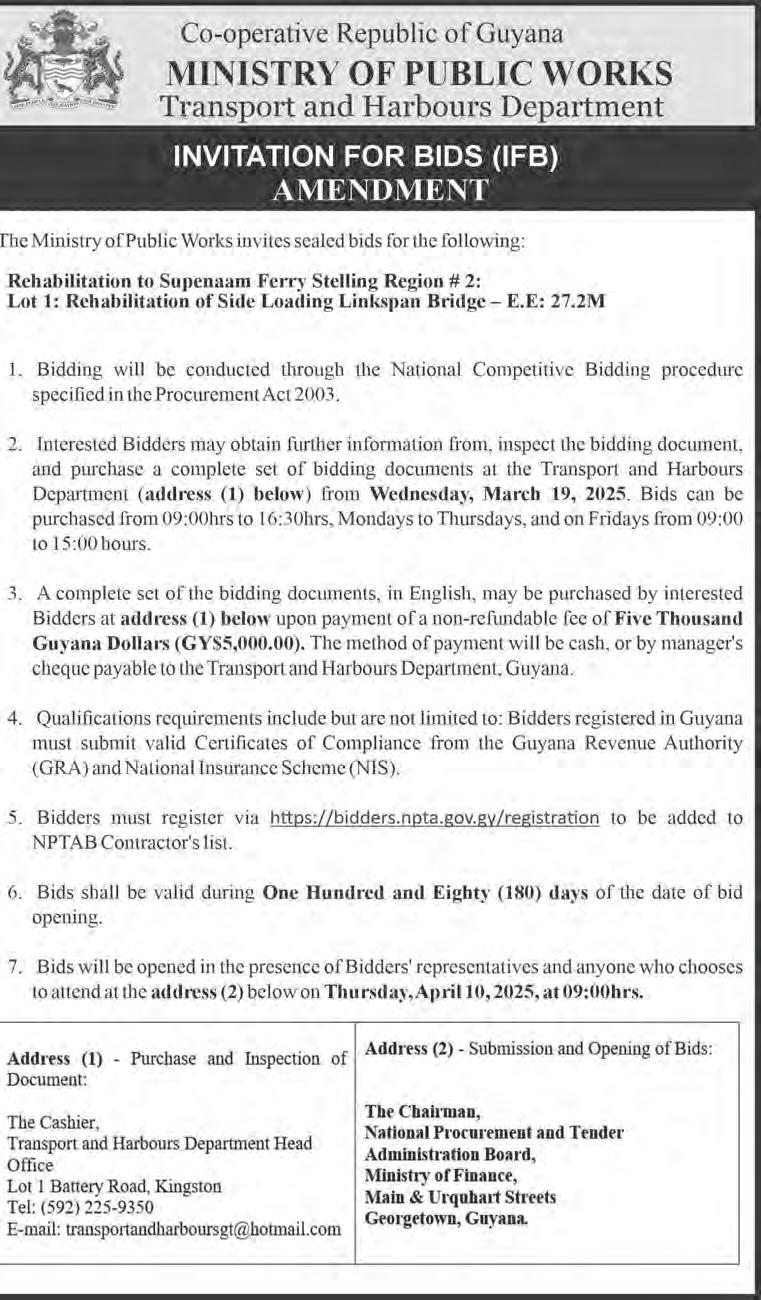







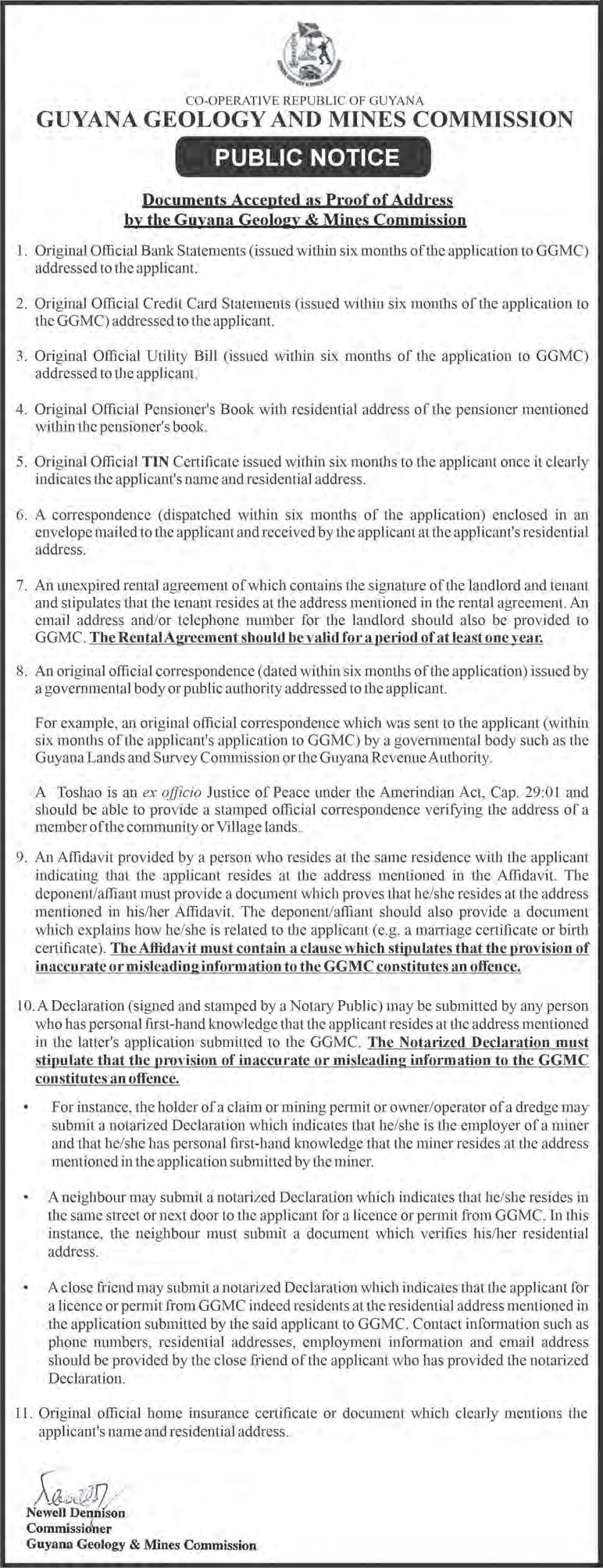













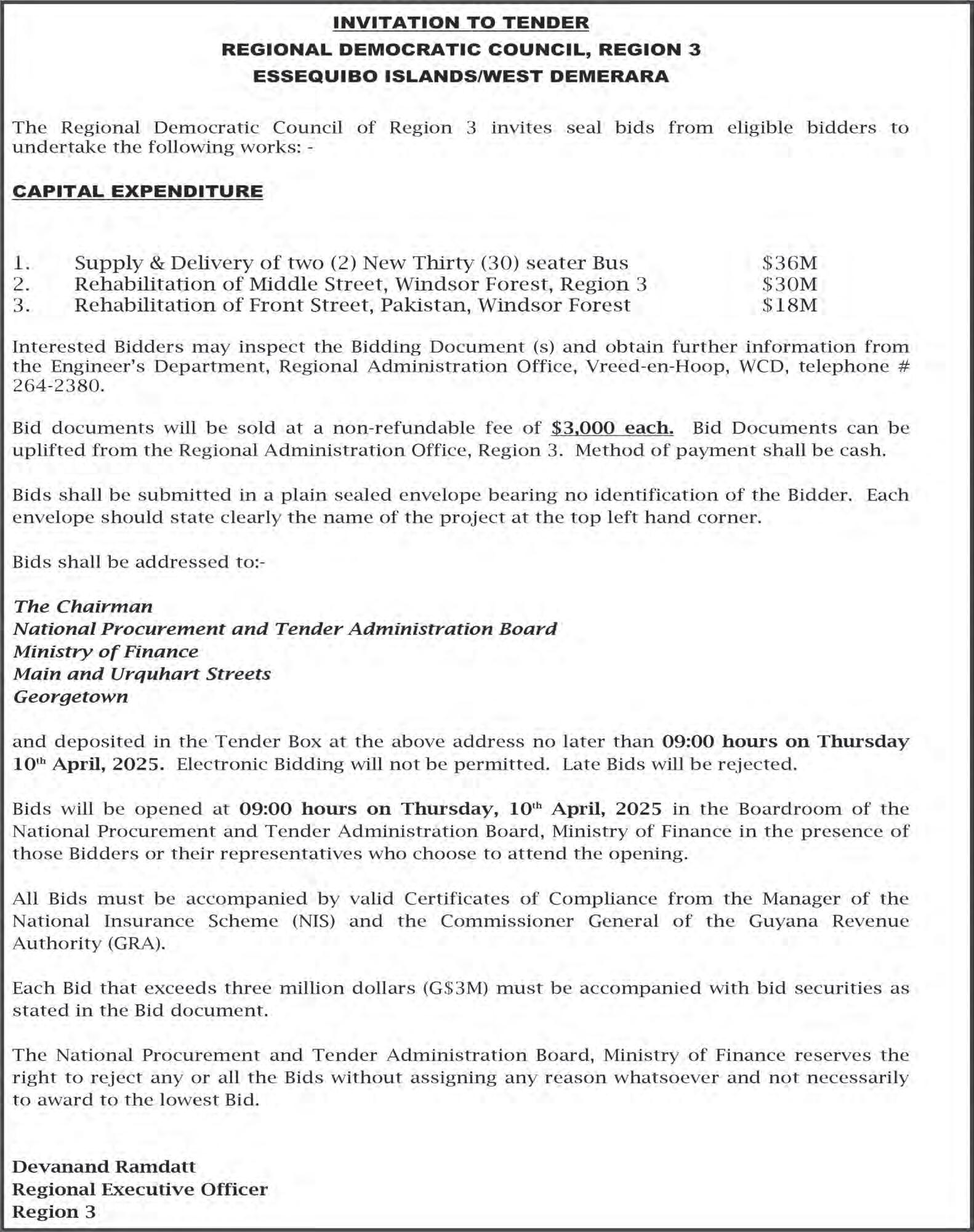






30, 2025
Dear Student, Welcome, dear reading friend. Study is an ongoing process. It becomes effective with constant improvement. Your productivity is sure to soar with the right study techniques, skills, and approaches and, moreso, with useful technological apps. Alongside your homework planner, have rapt in-class attention and teacher consultation, also a properly planned schedule with specific management of goals for each term and study session. Include sleep and relaxation time also. Yes, a suitable study posture always works. Be wise.
Love you.
IMPROVING GRAMMAR
Self-test
Note: Self-testing in language and grammar involves you repeatedly and independently assessing your knowledge and skills through practice questions, exercises, or tests to identify areas for improvement and track your progress. Self-testing builds your confidence in areas formerly in disarray. With this tool you get to focus on your learning efforts efficiently. Test types can be objective or subjective, oral or written, etc.
Below, find two exercises to self-test your aptitude in grammar and language courses.
A.. Test your ability to use verbs correctly by choosing the correct verb form in brackets in each of the following sentences.
1. Water buffaloes (was, were) the subject that everyone in Form VB worked on two weeks ago.
2. A long list of 256 words (was, were) in last week’s Letter Scramble solution.
3. Either one word or a list of words (is, are) good for the occasion.
4. DART is one of the words that (was, were) in Inez’s crossword solution.
5. No shoes, hat, or tie (was, were) in Simon Peter ’s locker.
6. No paper, pen, or pencils (was, were) in Pamela’s possession.
7. Yvonne and Jean’s friend (was, were) the school Language Club’s president.
8. Angy, not Burnie’s friends, (was, were) responsible for the club’s lost Foreign Language file.
9. Randolph, not Nicola’s brother, (was, were) featuring in this year’s drama festival.
10. Old Roam Chester report-
Nation shall speak peace unto nation. DR. MONTAGUE JOHN RENDALL (1862-1950) BBC Motto written by Dr. Rendall, one of the Governors of the Corporation.
ed that a long list of retrenched workers (was, were) gathered outside the Public Work’s compound.
B.. Read the TEN sentences through to note their variety in structure. Then choose the correct verb form from those supplied in brackets.
1. Every father, mother, and teacher in this small village (is, are) contributing toward our education drive.
2. Many a one (has, have) attempted that dreaded examination and somehow succeeded.
3. More than one child in a family (has, have) lots of problems with the English Language grammar
4. More teachers than one (has, have) failed to correct these problems.
5. I know of one who (has, have) spent most of her career trying to be of help and succeeded much.
6. Do you know of anyone who (has, have) good mastery in all his or her major subject areas?
7. It (was, were) the children who paid much attention to their schoolwork that did well at their external examinations this year.
8. The successful children (was, were) those who had parents also interested in their welfare.
9. The children, not the older people, (is, are) the ones who must make up their mind to work harder while in school.
THE PASSAGE
Use the questions below the passage as guidelines for a better understanding of the passage.
The whole cabin was ablaze. Leaping from his bunk, and dragging the blankets with him, he sprang to the door, tore it open, and rushed out into the snow. ... According to custom, he had been sleeping almost fully dressed. ...
Outside in the snow Pete Noel stood, blinking through scorched and smarting lids at the destruction of his shack. For a second or two he stared down at the things he clutched in his arms, and wondered how he had come to think of them in time. Then, realising with a pang that
he needed something more than clothes and a rifle, he flung them down on the snow and made a dash for the cabin, in the hope of rescuing a hunk of bacon or a loaf of substantial woodman’s bread. Before he could reach the door, a flicker of flame shot out and hurled him back, half-blinded. Grabbing up a double handful of snow, he buried his face in it to ease the smart. Shaking himself, he coolly carried the treasures he had saved back to a safe distance from the flames, and resting on the blankets, he pulled on his larrigans. ...
A man who lives alone in the great solitude of the forest has every chance to become a philosopher. Pete Noel was a philosopher. Instead of dwelling upon the misfortunes which had smitten him, he chose to consider his good luck in having got out of the shack alive. When he put on his coat, he noted, with satisfaction, that his spacious pockets contained matches, tobacco, his pipe, his heavy clasp-knife, and his mittens.
Something to Do
1. Next, Pete Noel will: (a) give up hunting; (b) get to the nearest shelter; (c ) build a new cabin; (d) put out the fire).
2. The things Pete Noel had saved were called treasures because: (a) they were worth a good deal; (b) he owned very few things; (c ) they could save his life; (d) he had only saved a few.
3. In Pete Noel’s pockets were: (a) tobacco, nails, a knife, pipe, and mittens; (b) a pipe, mittens, bread, matches and tobacco; (c ) tobacco, matches, bread, nails, and mittens; (d) mittens, a pipe, matches, a claspknife, and tobacco.
4. Can you safely say that Pete Noel was in the grip of a nightmare when he woke up in a cabin on fire? Justify.
5. Why did Pete sleep almost fully dressed? (a) He ne ver knew when to expect fire. (b) He wanted to be ready for any danger. (c ) It was cold. (d) He was too lazy to undress.

a child may suffer a blow to a tooth without it being displaced from its normal position. The structures supporting it would be injured. This condition is called a concussion. The tooth is usually tender to biting pressure and may shake, with bleeding occurring around the crown. No treatment is indicated other than slight filing of the chewing surface if the child complains of biting sensitivity. Mobile teeth gen erally tighten up on their own after a few weeks. The parent should be instructed to give the child a soft diet and eventually return to normal foods according to the child’s tolerance. The future for concussed teeth is good.
The dental health of a person is primarily decided during the preschool pe riod of that person’s life, and the role played by the parent or guardian is an essential factor. While tooth decay is the p rincipal agent which decimates an individual’s oral health, traumatic injuries form an important part of this, especially in children. A recent study of injuries to primary teeth showed children aged two to four had the highest incidence. Falling has been described as the most common cause of dental injury, and the most common type of injury to the primary dentition is displacement. Other studies have shown soft tissue injuries and enamel-dentine fractures to be the most prevalent. Clinical evaluation of the injured pre-school child can be difficult because the dentist often deals with distraught parents and a frightened and uncooperative child. Crown fractures of primary teeth involving enamel only are usual -
ly not restored or filled. All that is needed is a slight recontouring of the biting edge to improve aesthetics. However, the involvement of dentine in the crown fracture necessitates restoration to seal the exposed dentinal tubules that contain nerve endings. Because of short roots, root fractures in primary teeth are unusual. The location of a root fracture in a primary tooth usually determines the outcome. Only when the X-rays show that the tip is broken should they be treated. When the fracture is closer to the crown, the tooth is usually dark and shaky and must be extracted. Displacement occurs more frequently than a crown or root fracture because of the resiliency of the alveolar bone and short tooth roots. These injuries may be extrusive (the tooth being knocked straight outw ard), lateral, or intrusive (driven deeper into the jaw bone). In most cases, these displaced teeth must be r emoved. The dentist analyses the clinical picture before deciding to extract the displaced tooth. Trauma to temporary teeth can cause psychological affliction to the child, unlike in adults. If these teeth require more than six months to be replaced by the underlying new ones, special effort must be made to preserve them in the dental arch. Failure to do so could result in crowding (“riders”) and malocclusion (abnormal bite) unless a space retainer (a type of denture) is fabricated for the child. Parents should not insist on extraction but should allow the dentist to advise them on the proper r ecourse so that any hasty action will not be regretted.

